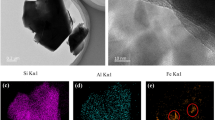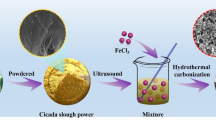Abstract
The aim of this study was to synthesize a novel lanthanum (La) doped catalyst and to investigate antipyrine removal in wastewater using the Fenton-like process with the catalyst. The La-doped Co-Cu-Fe catalyst was synthesized using the modified hydrothermal method. Results showed that the La-doped catalyst had higher specific surface area and lower particle size than the catalyst without La doping (i.e., the control) (267 vs. 163 m2/g and 14 vs. 32 nm, respectively). Under the conditions of catalyst dosage 0.5 g/L, H2O2 concentration 1.70 g/L, and NaHCO3 0.1 g/L, the antipyrine removal within 60 min using the Fenton-like process with the La-doped catalyst was much higher than that with the control (95% vs. 54%). The hydroxyl radical concentration with the La-doped catalyst within 60 min was two times higher than that with the control (49.2 vs. 22.1 µg/L). The high catalytic activity of La-doped catalyst was mainly attributed to its high specific surface area based on the X-ray photoelectron spectroscopy result. Our La-doped catalyst should have great potential to remove antipyrine in wastewater using the heterogeneous Fenton-like process.

Similar content being viewed by others
References
Bokare A D, Choi W (2014). Review of iron-free Fenton-like systems for activating H2O2 in advanced oxidation processes. Journal of Hazardous Materials, 275: 121–135
Cai M Q, Feng L, Jiang J, Qi F, Zhang L Q (2013). Reaction kinetics and transformation of antipyrine chlorination with free chlorine. Water Research, 47(8): 2830–2842
Ding Y, Tang H, Zhang S, Wang S, Tang H (2016). Efficient degradation of carbamazepine by easily recyclable microscaled CuFeO2 mediated heterogeneous activation of peroxymonosulfate. Journal of Hazardous Materials, 317: 686–694
Divya T, Renuka N K (2015). Modulated heterogeneous Fenton-like activity of ‘M’ doped nanoceria systems (M = Cu, Fe, Zr, Dy, La): Influence of reduction potential of doped cations. Journal of Molecular Catalysis A Chemical, 408: 41–47
Evgenidou E N, Konstantinou I K, Lambropoulou D A (2015). Occurrence and removal of transformation products of PPCPs and illicit drugs in wastewaters: A review. Science of the Total Environment, 505: 905–926
Fareghi-Alamdari R, Golestanzadeh M, Zekri N (2014). Application of nanosized Cu0.5Co0.5Fe2O4 spinel ferrite as a nanocatalyst in the synthesis of 14-aryl-14h-dibenzo[a,j] xanthene derivatives under solvent-free conditions. Journal of the Chinese Chemical Society, 61 (12): 1341–1350 (in Chinese)
Fida H, Zhang G, Guo S, Naeem A (2017). Heterogeneous Fenton degradation of organic dyes in batch and fixed bed using La-Fe montmorillonite as catalyst. Journal of Colloid and Interface Science, 490: 859–868
Fischbacher A, von Sonntag C, Schmidt T C (2017). Hydroxyl radical yields in the Fenton process under various pH, ligand concentrations and hydrogen peroxide/Fe(II) ratios. Chemosphere, 182: 738–744
Fraigi L B, Lamas D G, Walsöe De Reca N E (2001). Comparison between two combustion routes for the synthesis of nanocrystalline SnO2 powders. Materials Letters, 47(4–5): 262–266
Gong H, Chu W, Chen M, Wang Q (2017). A systematic study on photocatalysis of antipyrine: Catalyst characterization, parameter optimization, reaction mechanism a toxicity evolution to plankton. Water Research, 112: 167–175
Gultekin I, Ince N H (2004). Degradation of reactive azo dyes by UV/ H2O2: Impact of radical scavengers. Journal of Environmental Science and Health, Part A, 39(4): 1069–1081
Jiang J, Li G, Li Z, Zhang X, Zhang F (2016). An Fe-Mn binary oxide (FMBO) modified electrode for effective electrochemical advanced oxidation at neutral pH. Electrochimica Acta, 194: 104–109
Lei Y, Chen C S, Tu Y J, Huang Y H, Zhang H (2015). Heterogeneous degradation of organic pollutants by persulfate activated by CuO-Fe3O4: Mechanism, stability, and effects of pH and bicarbonate ions. Environmental Science & Technology, 49(11): 6838–6845
Li F, Lei T, Zhang Y, Wei J, Yang Y (2015). Preparation, characterization of sludge adsorbent and investigations on its removal of hydrogen sulfide under room temperature. Frontiers of Environmental Science & Engineering, 9(2): 190–196
Li W, Liu H, Chen Y (2017). Promotion of transition metal oxides on the NH3-SCR performance of ZrO2-CeO2 catalyst. Frontiers of Environmental Science & Engineering, 11(2): 6
Lyu L, Zhang L, Hu C (2015). Enhanced Fenton-like degradation of pharmaceuticals over framework copper species in copper-doped mesoporous silica microspheres. Chemical Engineering Journal, 274: 298–306
Ma J, Graham N J D (2000). Degradation of atrazine by manganese-catalysed ozonation—influence of radical scavengers. Water Research, 34(15): 3822–3828
Monteagudo J M, Durán A, Latorre J, Expósito A J (2016). Application of activated persulfate for removal of intermediates from antipyrine wastewater degradation refractory towards hydroxyl radical. Journal of Hazardous Materials, 306: 77–86
Munoz M, De Pedro Z M, Casas J A, Rodriguez J J (2015). Preparation of magnetite-based catalysts and their application in heterogeneous Fenton oxidation: A review. Applied Catalysis B: Environmental, 176–177: 249–265
Na H, Zhu T, Liu Z, Sun Y (2014). Promoting effect of Zr on the catalytic combustion of methane over Pd/γ-Al2O3 catalyst. Frontiers of Environmental Science & Engineering, 8(5): 659–665
Ou X, Yan J, Zhang F, Zhang C (2018). Accelerated degradation of orange G over a wide pH range in the presence of FeVO4. Frontiers of Environmental Science & Engineering, 12(1): 7
Park C M, Heo J, Yoon Y (2017). Oxidative degradation of bisphenol A and 17α-ethinyl estradiol by Fenton-like activity of silver nanoparticles in aqueous solution. Chemosphere, 168: 617–622
Patil S R, Kumar L, Kohli G, Bansal A K (2012). Validated HPLC method for concurrent determination of antipyrine, carbamazepine, furosemide and phenytoin and its application in assessment of drug permeability through Caco-2 cell monolayers. Scientia Pharmaceutica, 80(1): 89–100
Rajasekhar Babu K, Rao K R, Rajesh Babu B (2017). Cu2+-modified physical properties of cobalt-nickel ferrite. Journal of Magnetism and Magnetic Materials, 434: 118–125
Rao Y, Zhang Y, Han F, Guo H, Huang Y, Li R, Qi F, Ma J (2018). Heterogeneous activation of peroxymonosulfate by LaFeO3 for diclofenac degradation: DFT-assisted mechanistic study and degradation pathways. Chemical Engineering Journal, 352: 601–611
Rashad M M, Rayan D A, Turky A O, Hessien M M (2015). Effect of Co2+ and Y3+ ions insertion on the microstructure development and magnetic properties of Ni0.5Zn0.5Fe2O4 powders synthesized using co-precipitation method. Journal of Magnetism and Magnetic Materials, 374: 359–366
Reddersen K, Heberer T, Dünnbier U (2002). Identification and significance of phenazone drugs and their metabolites in ground- and drinking water. Chemosphere, 49(6): 539–544
Samavati A, Mustafa M K, Ismail A F, Othman M H D, Rahman M A (2016). Copper-substituted cobalt ferrite nanoparticles: Structural, optical and antibacterial properties. Materials Express, 6(6): 473–482
Sharma R, Bansal S, Singhal S (2016). Augmenting the catalytic activity of CoFe2O4 by substituting rare earth cations into the spinel structure. RSC Advances, 6(75): 71676–71691
Su C, Li W, Liu X, Huang X, Yu X (2016). Fe-Mn-sepiolite as an effective heterogeneous Fenton-like catalyst for the decolorization of reactive brilliant blue. Frontiers of Environmental Science & Engineering, 10(1): 37–45
Tai C, Peng J F, Liu J F, Jiang G B, Zou H (2004). Determination of hydroxyl radicals in advanced oxidation processes with dimethyl sulfoxide trapping and liquid chromatography. Analytica Chimica Acta, 527(1): 73–80
Tan C, Gao N, Deng Y, Rong W, Zhou S, Lu N (2013). Degradation of antipyrine by heat activated persulfate. Separation and Purification Technology, 109: 122–128
Tan C, Gao N, Fu D, Deng J, Deng L (2017). Efficient degradation of paracetamol with nanoscaled magnetic CoFe2O4 and MnFe2O4 as a heterogeneous catalyst of peroxymonosulfate. Separation and Purification Technology, 175: 47–57
Wang J, Wang S (2016). Removal of pharmaceuticals and personal care products (PPCPs) from wastewater: A review. Journal of Environmental Management, 182: 620–640
Wei J, Zhang X, Liu Q, Li Z, Liu L, Wang J (2014). Magnetic separation of uranium by CoFe2O4 hollow spheres. Chemical Engineering Journal, 241: 228–234
Wu C, Linden K G (2010). Phototransformation of selected organophosphorus pesticides: Roles of hydroxyl and carbonate radicals. Water Research, 44(12): 3585–3594
Yao Y, Chen H, Lian C, Wei F, Zhang D, Wu G, Chen B, Wang S (2016a). Fe, Co, Ni nanocrystals encapsulated in nitrogen-doped carbon nanotubes as Fenton-like catalysts for organic pollutant removal. Journal of Hazardous Materials, 314: 129–139
Yao Y, Chen H, Qin J, Wu G, Lian C, Zhang J, Wang S (2016b). Iron encapsulated in boron and nitrogen codoped carbon nanotubes as synergistic catalysts for Fenton-like reaction. Water Research, 101: 281–291
Zhang H, Chen S, Zhang H, Fan X, Gao C, Yu H, Quan X (2019). Carbon nanotubes-incorporated MIL-88B-Fe as highly efficient Fenton-like catalyst for degradation of organic pollutants. Frontiers of Environmental Science & Engineering, 13(2): 18
Zhang M, Lu J, He Y, Wilson P C (2016). Photocatalytic degradation of polybrominated diphenyl ethers in pure water system. Frontiers of Environmental Science & Engineering, 10(2): 229–235
Zhang T, Li J, He H, Song Q, Liang Q (2017). NO oxidation over Co-La catalysts and NOx reduction in compact SCR. Frontiers of Environmental Science & Engineering, 11(2): 4
Zhang X, Ding Y, Tang H, Han X, Zhu L, Wang N (2014). Degradation of bisphenol A by hydrogen peroxide activated with CuFeO2 microparticles as a heterogeneous Fenton-like catalyst: Efficiency, stability and mechanism. Chemical Engineering Journal, 236: 251–262
Zhou L, Song W, Chen Z, Yin G (2013). Degradation of organic pollutants in wastewater by bicarbonate-activated hydrogen peroxide with a supported cobalt catalyst. Environmental Science & Technology, 47(8): 3833–3839
Zuehlke S, Duennbier U, Lesjean B, Gnirss R, Buisson H (2006). Long-term comparison of trace organics removal performances between conventional and membrane activated sludge processes. Water Environment Research, 78(13): 2480–2486
Acknowledgements
This work was partly supported by grants from the National Key R& D Program of China (Nos. 2017YFB0903700 and 2017YFB0903703), the National Natural Science Foundation of China (Grant Nos. 51608547, 51278500 and 51308557), and the Fundamental Research Funds for the Central Universities (18lgpy43).
Author information
Authors and Affiliations
Corresponding author
Additional information
Highlights
• A La-doped Co-Cu-Fe catalyst was synthesized for the antipyrine (ANT) removal.
• The La-doped catalyst had higher ANT removal than the control (95% vs. 54%).
• La reduced the particle size and increased the specific surface area of catalyst.
Supporting materials
Rights and permissions
About this article
Cite this article
Wei, S., Zeng, C., Lu, Y. et al. Degradation of antipyrine in the Fenton-like process with a La-doped heterogeneous catalyst. Front. Environ. Sci. Eng. 13, 66 (2019). https://doi.org/10.1007/s11783-019-1149-9
Received:
Revised:
Accepted:
Published:
DOI: https://doi.org/10.1007/s11783-019-1149-9




